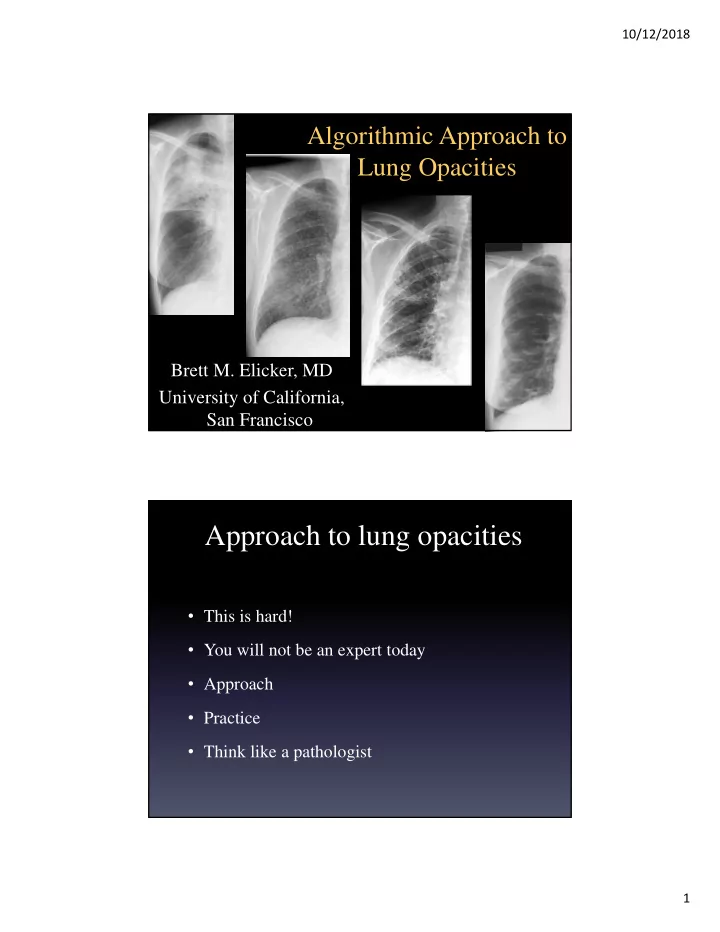

10/12/2018 Algorithmic Approach to Lung Opacities Brett M. Elicker, MD University of California, San Francisco Approach to lung opacities • This is hard! • You will not be an expert today • Approach • Practice • Think like a pathologist 1
10/12/2018 Categories of lung opacities • 1. Consolidation • 2. Interstitial (diffuse lines or nodules) • 3. Airways • 4. One or a few nodules 2
10/12/2018 Alveolar Interstitial 3
10/12/2018 Airways Not applicable 4
10/12/2018 Consolidation • Confluent opacity • Fluffy around periphery • Air bronchograms • Lack of volume loss Confluent opacity, no volume loss 5
10/12/2018 Air bronchograms 6
10/12/2018 Well-defined: Ill-defined: interstitial alveolar Consolidation • Acute vs. chronic symptoms • Distribution • Acuity of changes • Differential diagnosis in acute setting – Focal: pneumonia/aspiration, hemorrhage – Diffuse: edema, acute lung injury, pneumonia, hemorrhage 7
10/12/2018 2 month f/u 8
10/12/2018 Invasive mucinous adenocarinoma 4 month f/u Chronic alveolar disease Tumor • – Invasive mucinous adenocarinoma (aka multifocal bronchoalveolar CA) – Lymphoma (recurrent or 1 ° pulmonary) Inflammatory • – Organizing pneumonia – Chronic eosinophilic pneumonia – Sarcoidosis Other • – Lipoid pneumonia – Alveolar proteinosis 9
10/12/2018 Comparison 10
10/12/2018 Signs of atelectasis: volume loss Fissure Deviation of displacement mediastinal structures Elevated diaphragm Rapid change 11
10/12/2018 ? atelectasis or an alveolar process Atelectasis (types) • Obstructive/resorptive (obstruction of bronchus) • Passive (compression of lungs) • Cicatricial (related to scarring) • Adhesive (surfactant deficiency) 12
10/12/2018 Lung cancer (Golden S sign) 13
10/12/2018 Lower lobe atelectasis Combined RML/RLL atelectasis 14
10/12/2018 Left upper lobe collapse • 1. Veil-like density • 2. Volume loss – Elevated diaphragm – Elevated left PA • Luftsichel sign 15
10/12/2018 Interstitial opacities Nodules Lines 16
10/12/2018 Nodules: diff dx • Hematogenous spread – Miliary tuberculosis – Miliary fungal infection (e.g. cocci) – Metastases • Lymphatic spread – Sarcoidosis – Lymphangitic spread of tumor – Pneumoconioses (e.g. silica) Histoplasmosis 17
10/12/2018 Miliary tuberculosis Interstitial: lines 18
10/12/2018 Causes of interstitial lines • Edema Kerley-b lines may be present • Malignancy • Fibrotic lung diseases (this These lines are typically thick, wavy and irregular is a long list) Linear opacities 19
10/12/2018 Pulmonary edema (kerley-b lines) 20
10/12/2018 Reticular opacities (distribution) • Lower lobe predominant – Idiopathic pulmonary fibrosis – Connective tissue disease – Drugs – Asbestosis – Hypersensitivity pneumonitis • Upper lobe predominant – Sarcoidosis – Prior TB/fungus – Pneumoconioses 21
10/12/2018 Idiopathic pulmonary fibrosis Hypersensitivity pneumonitis 22
10/12/2018 Tuberculosis 23
10/12/2018 Airways disease • Circular • Tubular 24
10/12/2018 Differential diagnosis of airways disease • Mild: • Severe: – Asthma – Bronchiolitis obliterans – Viral infection – Immunodeficiency – Chronic bronchitis – Ciliary dyskinesia – Etc. – Cystic fibrosis – ABPA – Tuberculosis – Cartilage diseases 25
10/12/2018 Cystic fibrosis Which compartment of lung is affected? 26
10/12/2018 Solitary pulmonary nodule: differential diagnosis • Granuloma • Hamartoma • Primary bronchogenic carcinoma • Metastasis • Lots of others 27
10/12/2018 Which one is malignant? Nodules: benign vs. malignant Benign Malignant Small size Large size Smooth border Spiculated border No or irregular Diffuse calcification calcification Stability over time Growth over time 28
10/12/2018 Nodule: size Nodule: calcification 29
10/12/2018 Nodule borders So you see a nodule on CXR… • 1. Is it actually a nodule? 30
10/12/2018 ? nodule Shallow obliques 31
10/12/2018 ? nodule Apical lordotic 32
10/12/2018 So you see a nodule on CXR… • 1. Is it actually a nodule? • 2. Look for prior films? • 3. Is diffuse calcification present? Dual energy subtraction x-ray 33
10/12/2018 So you see a nodule on CXR… • 1. Is it actually a nodule? • 2. Look for prior films? • 3. Is diffuse calcification present? • 4. Get a CT scan or a follow-up CXR Category Subcategory CXR features Common causes •Confluent opacities •Edema Alveolar •Air bronchograms •Acute lung injury •Fluffy edges •Infection •Tuberculosis •Small, well ‐ defined nodules •Fungal infection Nodules •Opacities not confluent •Metastases •Normal lung between nodules •Sarcoidosis Interstitial •Thin, fine, delicate lines Lines •Pulmonary edema •Lines at periphery of lung (kerley ‐ b) •Cancer (kerley ‐ b) Lines •Fibrotic lung •Thick, wavy, irregular lines (reticular) disease •Circular or tubular Airways •Numerous causes •Thin or thick walled •Lung cancer Not in a single •One or a few nodules ( ≤ 3 cm) or •Metastasis compartment masses (>3 cm) •Granuloma •Hamartoma 34
10/12/2018 Algorithmic Approach to Lung Opacities On to the cases… 35
10/12/2018 36
10/12/2018 37
10/12/2018 38
Recommend
More recommend